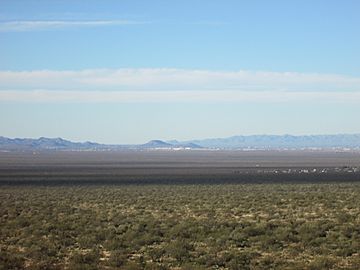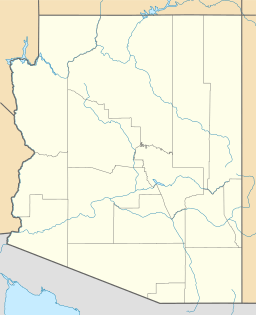Tumamoc Hill facts for kids
Quick facts for kids Tumamoc Hill |
|
|---|---|

View across the Tucson Basin towards Tumamoc Hill (left) and "A" Mountain (center)
|
|
| Highest point | |
| Prominence | 3,108 ft (947 m) |
| Geography | |
| Parent range | Tucson Mountains |
Tumamoc Hill (in the O'odham language: Cemamagĭ Doʼag) is a small, isolated hill called a butte. It is located just west of downtown Tucson, Arizona. This hill is home to many radio and television transmitters, which send out signals.
Tumamoc Hill is also a very special place for nature and history. It's an 860-acre ecological reserve and a National Historic Landmark. This means it's protected for its important natural environment and its historical value. The Carnegie Institution first set it aside in 1903. Today, the University of Arizona owns a large part of it and uses it for important research and education. There's even a small observatory with a telescope on the hill! Tumamoc Hill is a well-known landmark, a place for scientific study, and a popular spot for people in Tucson to visit.
Contents
Tumamoc Hill: A Special Place
Tumamoc Hill has a few important official titles:
- It's a National Environmental Study Site. This means it's a great place to learn about nature.
- It's an Arizona State Scientific and Natural Educational Area. This helps protect it for science and learning.
- It's a National Historic Landmark. This recognizes its important history.
- It's on the National Register of Historic Places. This also helps protect its historical value.
A Look Back: Tumamoc's Ancient Past
The name "Tumamoc" comes from the O'odham language and means "regal horned lizard". This hill was once home to the ancient Hohokam people.
Who Lived Here?
Tumamoc Hill is where the earliest known "trincheras" village was found. A trincheras village is a settlement built on a hillside with stone walls or terraces. Here, there are 160 foundations of round stone buildings and large stone walls around the edges. More than 460 ancient rock carvings, called petroglyphs, and a prehistoric garden near the hill show how important Tumamoc was to these people.
For many years after the Hohokam, about 1,300 years ago, the hill continued to provide resources for other Native American groups. These included the Tohono O'odham, Akimel O'odham, and the Hopi people. It is also believed to be a burial site for the Apache and O'odham people.
An Old Story: Captain Manje's Visit
A Spanish military leader, Captain Juan Mateo Manje, visited Tumamoc Hill with Father Kino between 1693 and 1701. He wrote about what he saw:
We passed in sight of, and around, a mountain where there are 100 terraces of stone wall in the form of a snail, spiraling to the top. They say it forms an armory, where in former wars those who gained the heights first were usually victors. Those who reached the first ring went around to the second, and as far as was necessary to exhaust the supply of arrows of those below. Then they came down from the mountain and fell upon their enemies and killed them.
Captain Manje's words suggest that these stone terraces were used for defense in ancient battles. People would climb the hill, using the terraces for protection, and then attack their enemies below. This shows how important the hill was for safety and strategy long ago.
Later, in the late 1800s, European settlers valued the rock and clay from the hill for building. Around the early 1900s, scientists chose Tumamoc Hill for the site of the Carnegie Institute's Desert Laboratory. Today, the hill is still a special landmark and a peaceful place for the people of Tucson.
Tumamoc Today: Fun and Learning
The road up Tumamoc Hill is a very popular place for walking and running. You can find the entrance to the road across from St. Mary's Hospital. It's open to people walking in the early mornings and evenings. The steep climb gives you a great workout and amazing views of the whole city. Sometimes, there are even talks for the public about the hill's unique history and nature.
Studying Nature: The Desert Laboratory

In 1903, a chief botanist named Frederick V. Colville convinced the Carnegie Institute to create a Desert Laboratory near Tucson. The main goal was to study how desert plants adapt to their environment. They hoped this research could help improve farming in the desert.
Early Days of Science
Many important scientists worked at the Desert Laboratory. They helped create the field of ecology in the United States. Ecology is the study of how living things interact with each other and their environment. These scientists even started a journal called Plant World, which later became a major science journal called Ecology. This research continued until the 1940s.
What Scientists Learned
Because of money problems during the Great Depression, the Carnegie Institute gave the Desert Laboratory to the Forest Service in 1940. They first offered it to the University of Arizona for only $1, but the university said no. Twenty years later, in 1960, the University of Arizona finally bought the reserve.
Scientists have been watching and experimenting with the plants on Tumamoc Hill for a very long time. This long-term research has taught us many things. For example, they learned about how saguaro cactus populations grow and shrink. They also found out that blue palo verde trees depend on areas with water. Scientists have also studied diseases and other dangers to desert tortoises. They even looked at how tiny winter plants interact with the insects and rodents that eat their seeds.


